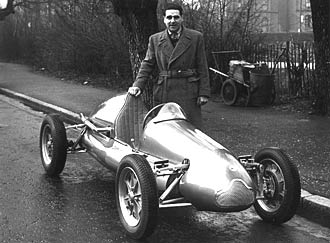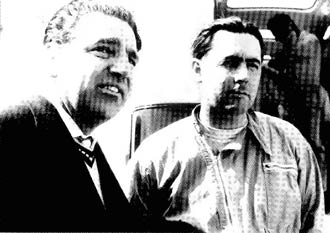John Cooper, who died on Christmas Eve from cancer, founded the Cooper Car Company with his father Charles, just after the Second World War. His death severs yet another link that joins the present day to the altogether more laid back days of 1950s-style Grand Prix racing.
 The company started serious production of rear-engined 500cc cars in 1948. The cars were simple and light, and the rear-engined concept would gradually change forever the face of not just Grand Prix racing, but cars that would compete in just about every category around the world.
The company started serious production of rear-engined 500cc cars in 1948. The cars were simple and light, and the rear-engined concept would gradually change forever the face of not just Grand Prix racing, but cars that would compete in just about every category around the world.
Coopers soon dominated the F3 and F2 scene, as motor racing grew in popularity in the increasingly prosperous Fifties. Just about every young aspiring driver would cut his teeth at the wheel of a Cooper racing car of some description, including Briton's first world champion Mike Hawthorn, and the man he beat to his title in 1958, Sir Stirling Moss.
It was Moss's victory in the 1958 Argentinean Grand Prix that would really put the little company from Surbiton firmly on the map. Moss was contracted to the Vanwall team for that year, but delays in changing their engines to run on new 'Avgas' fuel - and some uncertainties that the race would take place at all - meant that neither the BRM nor the Vanwall outfits would make the race. Moss was therefore able to tale up the offer from Rob Walker to drive his privately entered 2.0-liter Cooper in the event.
In the end, the combination of the little Cooper's good handling and the driving skill of Moss in conserving his car's tyres, saw them finish ahead of Luigi Musso's Ferrari by just 2.7 seconds after 80 laps of racing. The racing world was stunned, the big Italian teams - Ferrari and Maserati - had been humbled, and change was in the air.
If the result in Argentina had been a surprise, more was to come at the very next event at Monaco. With both the BRM and Vanwall teams returning to the grid, it would be the French driver Maurice Trintignant at the wheel of the Cooper for the classic race around the streets of the Principality of Monte Carlo. Once again the privately entered car would prove to be competitive and reliable, and would again lead home the Ferrari of Musso, and the works Cooper of Sir Jack Brabham, who finished fourth. Two races and two wins, it seemed scarcely believable. Furthermore, four British cars would finish in the top six, another sign that the balance of power in Grand Prix racing was rapidly changing.
 In the reprinted version of his book "Alf Francis - Racing Mechanic", Francis - Rob Walker's chief mechanic - relates that the total cost of the return trip by road to Monaco from the team's headquarters in Dorking in the UK was £300: £60 for the Commer lorries return trip across the channel ferry, £50 for petrol, and £3 per day expenses for each member of the team!
In the reprinted version of his book "Alf Francis - Racing Mechanic", Francis - Rob Walker's chief mechanic - relates that the total cost of the return trip by road to Monaco from the team's headquarters in Dorking in the UK was £300: £60 for the Commer lorries return trip across the channel ferry, £50 for petrol, and £3 per day expenses for each member of the team!
That would be it as far as race wins for the 1958 season was concerned. But, in the following two years Brabham would win back-to-back World Championships at the wheel of the works Coopers and they would win eleven races during these two seasons. These would be the halcyon days for John and Charles Cooper - their cars were dominating races all over Europe, and it appeared that this domination was set to continue for many years.
However, although the Coopers may have introduced the rear-engined concept to F1 racing, it was Colin Chapman at Lotus that went on to perfect it. When the 1.5-liter Formula was introduced for the 1961 season, it would increasingly be his cars that would set the pace, and the factory Coopers would score just one more victory - in the 1962 in Monaco Grand Prix, before the team was eventually sold to the Chipstead Garages Group in 1965.
The Cooper's team decline was no doubt accelerated by the serious injuries suffered by John Cooper in a road accident in 1963, whilst testing out a twin-engined version of a Mini Cooper he had been developing, and by the death of Charles Cooper in 1964. At the end of the '61 season Jack Brabham had also left the team to build his own car with which he would win the drivers' title in 1966.
It was also Cooper who started the rear-engined revolution at Indianapolis. At the end of the 1960 season, they took a completely standard 2.5-liter Formula One car to the 'Brickyard', and with Jack Brabham at the wheel, it lapped at an incredible average speed of nearly 145mph - just two miles per hour slower than the pole time set earlier that year. This caused something of a sensation, especially as the driver was new to the track and the engine was some 1.7-liters smaller than the 4.2-liter Offenhausers that were standard issue to all competitors at the time.
The car returned in modified form for the '61 race. It qualified thirteenth and finished ninth, still using only a 2.7-liter engine that produced only around 250 horsepower, and it was this effort that is largely credited with inspiring the later successful Lotus-Ford assaults on the Speedway, which eventually led to the first rear-engined win in 1965.
If only a relative handful of racing drivers could drive real racing Coopers on the tracks, thousands of ordinary motorists got to sample the joys of driving different variants of the legendary Mini-Coopers on the road. This was almost entirely the brainchild of John Cooper, and the little front wheel drive cars would dominate their class in saloon car racing and rallies for much of the sixties.
Coopers would score just two more race wins in F1 under its new ownership, before it slipped quietly into obscurity. In the early days of the 3-liter engine formula, Maserati-powered Coopers would win the '66 Mexican Grand Prix in the hands of John Surtees, and their final victory would be achieved with Pedro Rodriguez at the wheel, at the 1967 South African Grand Prix. In all, Coopers would take part in 129 F1 World Championship events, winning 16 races over a nine-year period.
Overall, perhaps, the biggest impact that the Cooper Car Company made on the world of single seater racing was its role in the development of a vibrant British racing industry, sections of which survive to this day. The success of those early Coopers created an appetite for affordable racing which created a market for companies like Lotus, Lola and many other small manufacturers, which in turn created huge opportunities for specialist suppliers.
A whole generation of mechanics and engineers gained their initial experience from this club-racing scene, and this would lead to the dominance by British cars in the seventies and eighties. Two of F1's biggest names - Ron Dennis and Sir Frank Williams - cut their racing teeth in this environment, Dennis as a mechanic with Cooper, and Williams as a dealer in second-hand racing cars and spare parts. Arguably, if Charles Cooper had been French or Italian, the current racing scene today could have been be very different.
As it was, he challenged the big racing names of the day, won races and Championships, and left an indelible mark on the history of motor sport.

